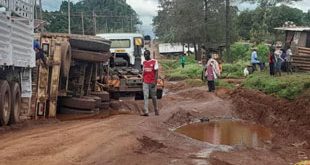
By Isaac Khisa
Paul Isaac Musasizi is the chief executive officer of Kiira Motors Project, the developers of the Kiira EV, an electric car conceptualized in Uganda. He spoke to Isaac Khisa about the prospects of local motor vehicle manufacturing.
How is your leadership style as a CEO?
I am very programmatic as a person who is involved at the brick and mortar level. I really want to be hand on across the divide. I believe it is important to empower my team so that it is able to work and even take critical decisions in real times if they have to do. At the heart of my leadership is ensuring that systems work. That is the foundation of leadership I aspire to bring on board because it is tested and proven to work.
How is your business strategy like in the development and growth of the Kiira Motor Corporation?
We have carefully crafted a 25-year strategic plan. Our eyes are on cheese, and that cheese, is that KMC must be an original equipment manufacturer in Uganda. By 2040, we must have a vehicle engineered here to at least 95%. So far, we have completed two vehicles -electric and hybrid, and we are now making a third one (a solar-powered bus). Making vehicles is something we know a little bit about but we need to learn how to manufacture them.
In order to do that quickly, we need to partner with an existing automotive original equipment manufacturer, who has the reputation and tested technology so that we do not struggle in production. We shall start with the capacity to produce 7,000 units before doubling, and ultimately reaching 60,000 vehicles per annum at full capacity – based on demand.
We hope to produce vehicles at full capacity by 2039 as we conquer markets not only domestic but also export markets especially in East and Central Africa. Currently, South Africa, the leading vehicle producer in Africa, is producing slightly over 500,000 units per annum, with more than 80 % exported mainly to South and North America, Europe, China, and the Middle East.
How do you plan to access experts and skilled labour to man the project?
Definitely, if you are venturing into a green field of this nature, you need to get the core right. Currently, we have a team of 28 people, most of who have been with us over the last three years. At least, we have the starting team and when we reinforce it with specialized skills, which we are already doing, get more staff to plug into those; we should be ready to go. We are planning to train our people, not only the engineers, but also those in marketing and financing within and outside the country.
At the moment, our team is comprised of only Ugandans though we would continue working with international consultants especially in the next six years so that we don’t make outrageous mistakes. We will also hire automotive supervisors so that they keep on checking on our programme and informing our board of directors on how we are doing, catch the gaps, and celebrate the milestones.
There are people who argue that Uganda has no capacity whatsoever to implement the proposed KMC project due to extremely low levels of practical engineering and technical training at our universities and technical institutions. What is your comment on this?
If we made an electric vehicle in the past, is it very difficult to manufacture someone’s car? Let us be sincere. We should be able to manufacture because we are not creating a new philosophy; we are adding value to an eco-system. You develop capacity by doing like it was done in China and Korea. The best teacher is experience. Where did Mark Zuckerberg learn how to do Facebook, Bill Gates on how to do software? Who taught Steve Jobs how to make the i-phone, Apple computer? Industrialization is not taught in school, it is taught in a garage, and we have been in the garage. It is surprising that people are counting to see the new car now to 2018 and not from the time we started working on the project. We have been working since 2008. We should really be making vehicles in the remaining months, there’s no doubt about that. In Nigeria last year, Nissan moved from zero cars manufactured, signed agreements, and the first car was off the assembly line after only six months. So, yes it is possible. The approach we are taking is not to wait until we develop our own shock. We start by working on someone’s vehicle, it is doing well, people know it, and they take it. So, it is a matter of signing an agreement with the partner, and we are off the ground.
What is the rationale for KMC to venture in producing hybrid vehicles and not fully electric or fossil?
Actually, we are not going to manufacture electric or hybrid vehicles. Developing an electric car was a good idea because 2008-2010 were years when the whole world was very aware of the impact of transport technology on climate change. So, we thought that our energy would be best harvested and we would also receive good visibility for our automotive programme that we had just started at Makerere University. As such, we did a green vehicle in record time as a prototype.
Why aren’t you going to produce hybrid vehicles yet that is the expectations of the public?
The vehicles we are going to produce will not be hybrid because we still have technological gaps and they are expensive. The ordinary Ugandan may not support hybrid or electric vehicles. The exploration of alternative energy is very important to anyone who is interested in the automotive industry especially in the hope of becoming an original manufacturer.
What is the portfolio of vehicles that you intend to produce?
We are going to produce Pick-Up trucks ($32,000), Crossover ($28,000), Sedan ($25,000), and middle duty bus. The heavy vehicles will be running on diesel and small passenger vehicles will be running on petrol.
What strategies do you plan to undertake in selling your brand new vehicles in an environment dominated by cheap second hand vehicles?
It is part of our programme to work closely with the government and the rest of the community to ensure that we have a serious roadmap for regulating the importation of second hand vehicles. We also need to figure out how we can have automotive tailored financial products so that people can acquire new vehicles. In South Africa, you cannot import used vehicles, and honestly, we should also reach there at some point.
An attempt to mass produce a car that primarily serves private transport needs has been made before in East Africa— the Nyayo Pioneer in Kenya in 1986. Unfortunately four years later, the project failed due to inadequate funds without selling a single vehicle. What measures are you undertaking to ensure that KMC will not face a similar fate?
The little I know about Nyayo Pioneer in Kenya is that it had a public relations challenge and as it is known media can either make or break a good idea or innovation. I know that on the launch, their vehicle was not able to start. And, off-course, if something is also politically inspired, the failure to clock can mean very many things.
How do we continue facilitating something which has not been proven to work? So, public relation is one of the critical aspects to consider. If you have the right PR, you will be able to attract the right stakeholder, and this is a proven concept. We need to keep the message alive.
I strongly believe that Kiira is becoming a good brand, giving Uganda a good name. The issue of being able to galvanize funding is about positioning our progamme so that people can see what it really is, and they can provide necessary funding either within government, development financial institutions or amongst the private sector. Right now, we have partners who are interested to come in as long as the programme is captured very well, with a solid and competent team.
What happened with the company’s original prototype—the small Kiira EV- that was first arrived in 2011?
Kiira EV as a project was very successful. We started working on it at the time Makerere University was starting the Automotive Programnme in 2008. We didn’t actually have even money. Most of the time, it was Prof Tickodri-Togboa and I using our little money to facilitate the team, with the College of Engineering, Design, Art and Technology giving us a few computers. The development of Kiira EV was a proof of the concept. So, we wanted to send a message out there that there’s capacity for automotive engineering, automotive manufacturing in Uganda, with our ultimate vision that our people will see and be able to support us. And as fate would have it, we got the support upon completing the project, and here we are. We learnt from it, we are wiser, smarter, and we have made more friends.
The idea behind the successive stories of Kiira project was hatched at Makerere University in partnership with the government. Where does the implementation of KMC leave the institution in the growth of the company?
KMC is a limited liability company with two shareholders, Uganda Development Corporation holding 96% shares on behalf of the government, and Makerere University holding the remaining shares.
What plans do you have in the next few months ahead of 2018?
We have to build a plant, develop the team, and do vigorous marketing ahead of vehicle production.
Where would you like to see KMC in five years upon commencing vehicle production in 2018?
We expect to have started posting profits .
 The Independent Uganda: You get the Truth we Pay the Price
The Independent Uganda: You get the Truth we Pay the Price


